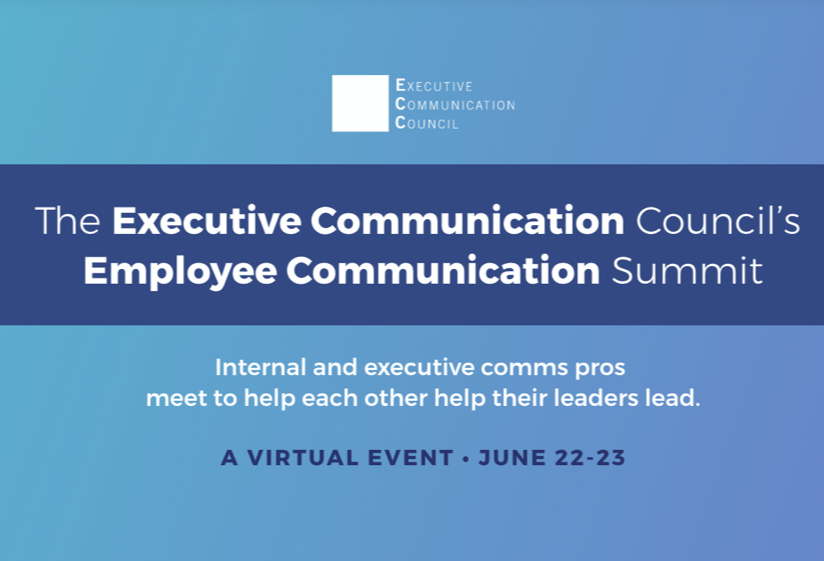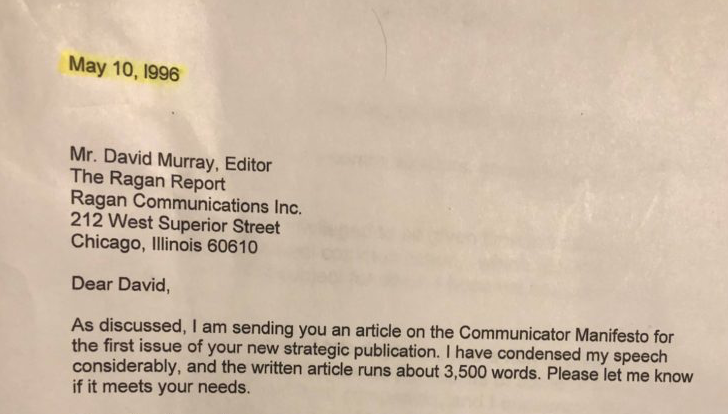To speak, or not to speak?
March 28, 2022
How speechwriters (and their clients) determine which invitations to accept, and which to turn down.
You could sense the desperation in the speechwriter’s email: “I’ve been tasked with developing rough guidelines to use when evaluating incoming speaking requests. In your travels, have you come across any resources (or anything, really!) that exec comms folks have used as a rubric?”
More speaking requests than leaders, or their speechwriters, can fulfill: the problem is age-old, but the dilemma has gotten worse over the last two years, especially for speechwriters.
As one scribe put it recently, “Since the world discovered virtual events in 2020, for some speakers, there is now no reason ever to say no. They don’t even have to get on a plane to hear encomiums from a new audience. Intoxicating! I think there is a real problem when ego is driving the schedule rather than strategy.”
We asked readers of our Executive Communication Report newsletter (to which you should subscribe; it’s free)—how they decide which invitations to accept, and which to turn down. Here is some of what we received, in the widely varying style and format in which it was offered.
***
From Lech Mintowt-Czyz, Executive Speechwriter, ADNOC Group, London:
Workflow/criteria for CEO engagement invitations
1. Is there a diary clash?
Yes: got to step 2
No: go to step 3
2. In the event of a diary clash assess the new opportunity against the existing opportunity using the criteria below (steps 3-9).
If the new opportunity is significantly better than the existing diary commitment consider:
a. The risks/rewards of pulling out of the original commitment.
b. The possibility of delegating attendance to the original commitment.
c. Whether it would be logistically possible to attend both (both from the perspective of the CEO diary and organizational capability).
If the new opportunity is broadly of the same scale as the existing one we should consider whether it would be logistically possible to attend both (both from the perspective of the CEO diary and organizational capability). If this is not possible, we should keep the original commitment so that we do not unnecessarily earn a reputation for being unreliable. In those circumstances we should seek to offer an alternative speaker/attendee to the organizers of the new opportunity, explaining that the CEO is already unavoidably committed elsewhere.
If the new opportunity is less attractive than the existing one we should seek to offer an alternative speaker/attendee to the organizers of the new opportunity, explaining that the CEO is already unavoidably committed elsewhere.
3. Is the opportunity consistent with the CEO’s positioning plan?
Yes: go to step 4
No: decline
4. Is the prestige/scale of the opportunity appropriate for the CEO, and will it deliver enough impact for the investment of his time he makes in attending? Key considerations:
· Is this an event other CEOs of similar weight have previously spoken at?
· How many people attend?
· What is the quality and relevance of the other companies/countries that attend?
· Is this an event which generates significant/international media coverage? What is the usual tone of the coverage and does it often mention CEO speakers?
· If it is a speech, is it a main stage plenary or a breakout; 20-minute keynote or five-minute remarks; or is it just a panel (where we have much less control and where the potential impact is generally significantly lower)?
· If it is a panel, what is the seniority of the other panelists? How many people are on the panel and how long is it slated to last i.e. will there be enough time for each panelist to have a good amount of time speaking? What is the quality of the moderator? Is there a guaranteed way to ensure we get a message across, by having a short intro speech or by agreeing questions in advance?
· Does the opportunity provide the chance to reach people beyond the room? Through third party social media, for example, or through the organizer publishing and promoting video content which includes the CEO? Is this an event used by important social media influencers/voices that we could seek to gain coverage through? Does the event hashtag generate significant volumes on social media?
· Does the opportunity allow us to reach entirely new audiences, which would otherwise not hear our messages, which we would like to reach?
· Is the audience profile such that they will be willing to listen to what we have to say and, potentially, be swayed by our messages?
5. What is the level of commitment being asked of the CEO? Is the opportunity good enough to make that level of commitment? Key considerations:
· Is it virtual or in person?
· Is travel involved? If so, how far and how long will the CEO need to be “on the road”?
· If the event is virtual, is it appropriate to contribute with a pre-recorded message? Or would that risk offending stakeholders?
· If the CEO needs to attend a virtual event in real time, how much of the event is it necessary for him to attend so that we do not offend the hosts, the audience or the other attendees?
· If the CEO contributes through a pre-record, what level of production is required and how does this impact on him?
6. Judge the opportunity on its potential to deliver business value. Key considerations:
· Would the CEO attending open up a business opportunity – some form of deal – for the company that would otherwise not be available?
· Would it put the CEO in the same room with a key stakeholder who he would otherwise not be able to reach?
· Is the event of a big enough scale to offer the opportunity for industry thought leadership? And, if so, do we have something we want/need to say in that space?
· Is the theme of the event, and the session being offered, consistent with a message we would want to project?
· Would attending also come with reputational risks? Are these manageable?
· Would a failure to attend have a significant negative impact on important partnerships/relationships for the company?
· Would another business director be a better fit for the opportunity offered and the stakeholders present?
· If the event is internal, does the CEO need to be in the lead, or could another business leader step in to ease the pressure on his diary?
***
From Justine Adelizzi, Principal & Founder, FEARLESScomms:
I love the event selection and management side of the job! Here’s a quick download on my best practices for making the events process work for you.
In general, an event request for a specific speaker should only be accepted if it meets all of the following conditions (ranked from most to least important):
- Addresses an audience or venue that is valuable to the speaker or organization.
- Covers a topic that is aligned with the speaker’s platform or priorities.
- Fits within the speaker’s broader lineup of speaking engagements (especially its proximity to other events on similar topics or to similar audiences).
- Fits within the speaker’s availability.
- Has a format that works with the speaker’s preferences.
Of the above conditions, only the first one is a true dealbreaker. If this isn’t an audience you want to speak to or a venue that you want to work with, that’s a hard decline that should leave little hope of a future event together. But just about everything else is negotiable (either now, or for a future engagement) if the audience or venue is good enough.
Organizer wants your speaker to address an issue that’s not part of their platform? Ask if there’s flexibility on the topic, or if your speaker could be kept in mind for an event on X, Y, or Z. Or ask if they’d be interested in another speaker from your organization.
Got too many events on X topic in Q1? Is your speaker interested in the event but unavailable on a specific date? Ask the organizer if it’s possible to move the event to a later time. If it’s a conference or something else that’s set in stone, ask to be kept in mind for a future event.
Event requesting a 30 minute keynote when your speaker prefers fireside chats? This one is usually the easiest to negotiate on–pitch a complete format change, or a hybrid.
***
From Tom Schmitz, Principal, Executive Communications, Pacific Gas and Electric Company:
Relevance: Is the organization asking us to speak about a subject/issue that fits with our communications objectives and overall strategy? Is the speaker they’ve requested the right person to represent the company on that topic?
Audience: Is the audience for the event one that we want to reach, educate or influence? Do they know us already, or will we be a new face to them? Will the reason our speaker is there be clear to all, or will we have to give them a reason to listen? Is the audience large enough? If small, is it too narrow to justify the investment of time and energy?
Context: Does the invitation make sense on its face, or do we need to probe deeper? Is our speaker being invited for the right reasons, or just because some event organizer is trying to fill a speaking slot with a boldface name? Is the date far enough in the future that we will have enough time to prepare? If it feels like a last-minute invite, could that be because some other speaker cancelled or fell-through? If the format is a panel discussion, what is our comfort level with the other panelists? Do we know/trust them? If the requested speaker is female, will she be the only woman in the group? If so, is there reason to suspect she was invited for that reason rather than her knowledge/perspective on the subject?
Currency: Are we being asked to do this as a favor by person/organization that we have a valuable relationship with? Will it give us an opening to cultivate one?
Media Exposure: Will media be there? If so, will this give us an opportunity to get our messages into any major publications, or offer individual interviews before or after the event?
Opportunity Cost: Even if the invitation does fit with our speaker and strategy, is the event consequential enough to justify the necessary time and energy? Is there a bigger/better stage that we should be saving our thunder for?
***
From Ben Rogers, Senior Manager, Speeches & Editorial, Lloyd’s of London:
It’s nothing complex, but I’ve introduced the framework below for handling requests:

Then it goes to our review panel (speechwriter, Head of Media and Head of Comms) to confirm the recommendation or get an opposing view.
As I say, quite straightforward, but it’s really helped processing all the requests we get!
***
From a speechwriter at a public pension fund:
- Is the opportunity for a keynote or a panel?
- If it is a panel – do you have a sense of who the other panelists could be?
- What is the topic or are we able to choose something ourselves as long as it aligns with the thrust of the event?
- If the timing doesn’t work for our CEO, would you consider having another senior executive with relevant knowledge and experience participate, or is this only at CEO level?
- Who would typically be in attendance in terms of audience composition?
- What media do you expect at the event?
***
From Diane Suchetka, Senior Manager of Executive Communications at The MetroHealth System, Cleveland, Ohio:
I always ask what’s expected in return. Do we have to buy a table at this event, for example, or is my CEO expected to stay and mingle afterward or attend a cocktail hour beforehand?
I always ask crowd size as well. Speaking to 10 people won’t cut it for my principle. He also refuses to give commencement speeches—too many drunk kids in the past.
***
From PSA Advisory Counsel member Isabelle Gaudeul-Ehrhart, former speechwriter to the President of the European Commission:
In the standard check-list I have crafted for the initial meeting with the speaker, I have two questions:
– Why did they invite you?
– Why did you accept?
It is the second that brings us to the heart of the matter. And usually when the realisation comes: “Ah, yes, you’re right. May be we shouldn’t…”
***
We included the super simple ones alongside the more elaborate because clearly not every organization needs an elaborate decision tree; for some organizations, a “big crowds, not too drunk” rule will suffice.
Reader, do you have another set of criteria that works for you? Send it to PSA executive director David Murray: [email protected], and he’ll add it to this collection.




